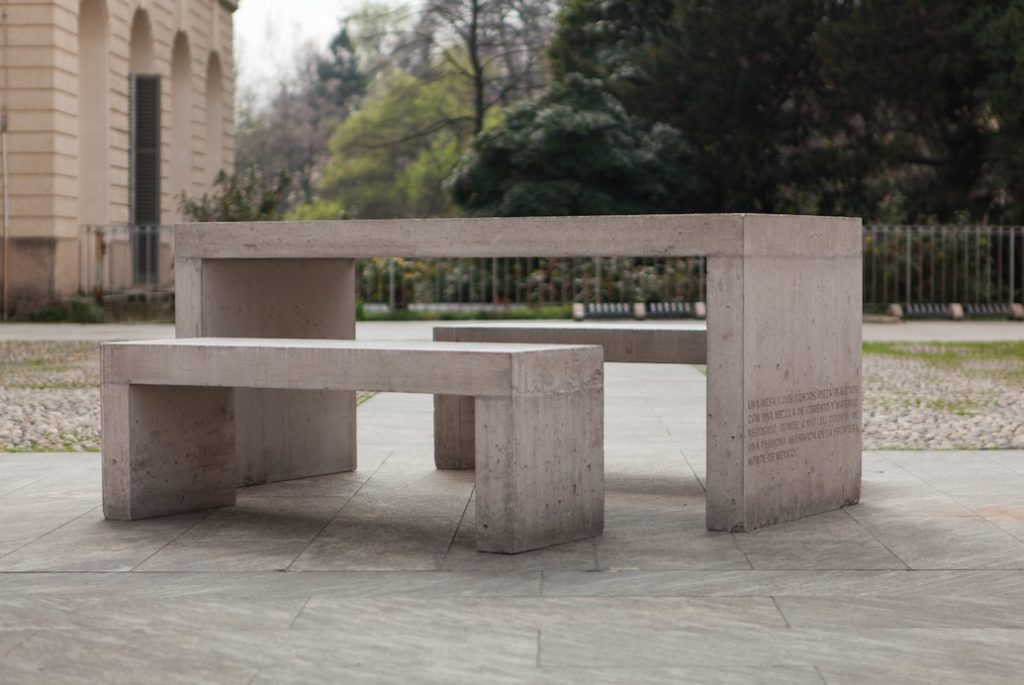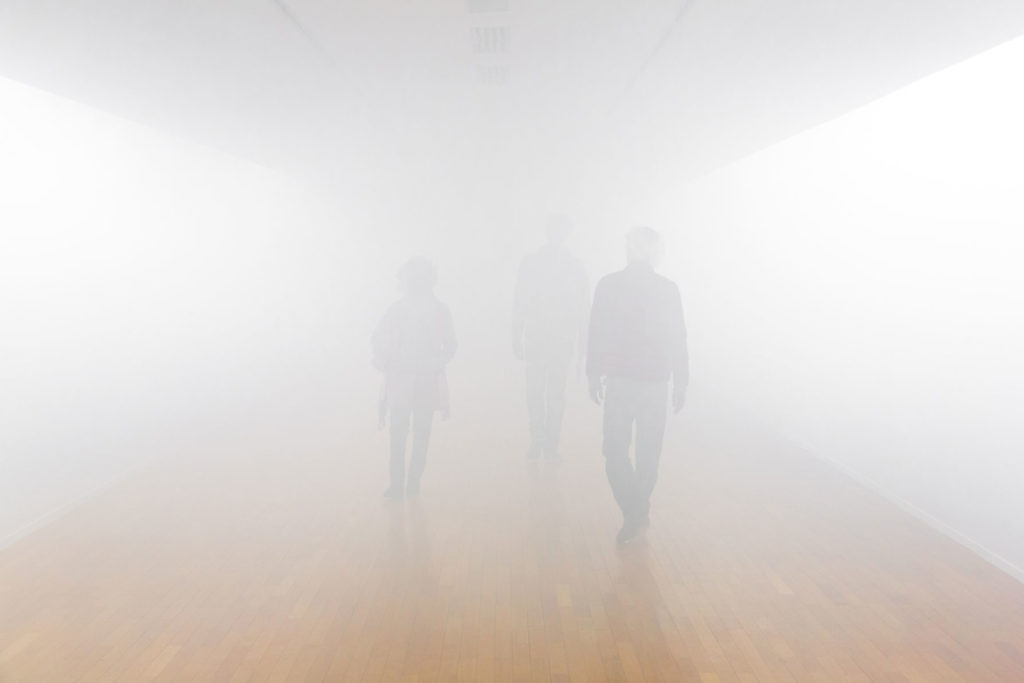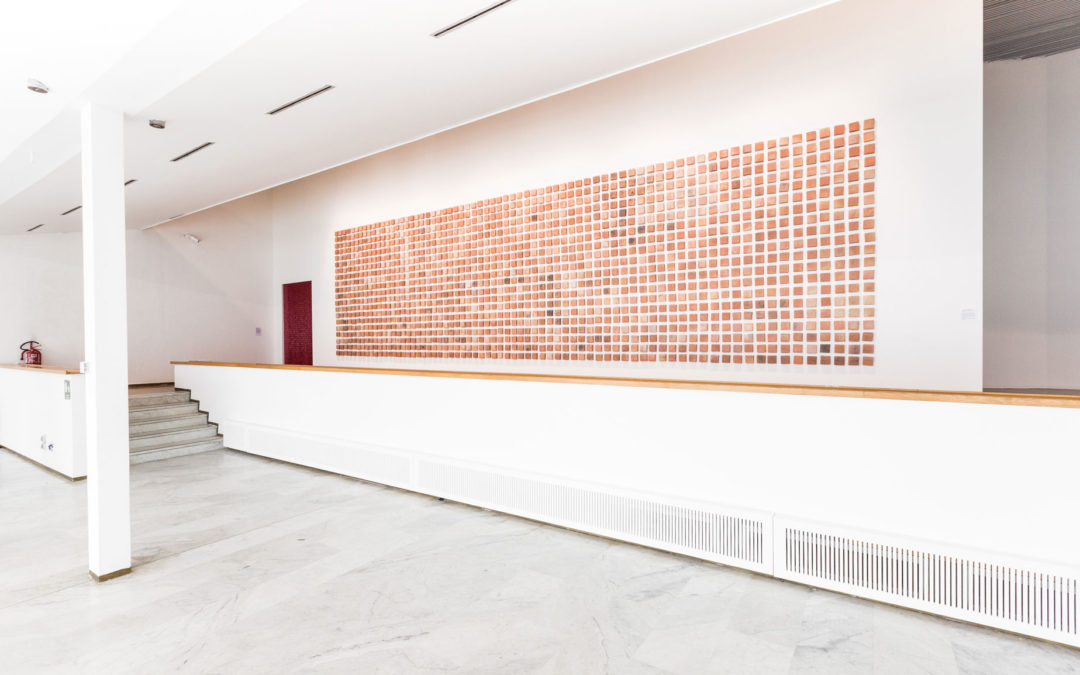by Dr Michela Coletta (Teaching Fellow in Hispanic Studies, University of Warwick and Associate Fellow, ILAS)
Exploring the exhibition ‘Ya basta hijos de puta’ in conversation with museum curator Diego Sileo.
PAC contemporary art museum, Milan, Italy
Teresa Margolles (Culiacán, 1963) creates connections through her work that meticulously yet intimately show the blurriness of boundaries: between life and death, wealth and poverty, power and marginality, us and them. Her exhibition at PAC museum of contemporary art in Milan starts in the museum courtyard, where waiting crowds are sitting or leaning on her work Table and two benches (2007), a life-size cluster made of thick concrete. They are plain-looking everyday objects, commonly found in public spaces, which people instinctively gather around to interact, communicate and socialize. But what appears to be an unremarkable and untainted object hides the traces of social violence and death: the concrete has been mixed with materials from the spot where a corpse on the border of northern Mexico was found. This act of violence, which occurred in Mexico as a result of the drug war that has plagued the country for decades, silently insinuates itself into the everyday life of a European city through the global networks of consumption.
After training in forensic medicine, for ten years Teresa Margolles worked with the artist collective SEMEFO (Servicio Médico Forense), which she co-founded in Mexico City in 1990 to document and report on contemporary society’s systems of marginality and violence. Her work is the result of her first-hand engagement with some of the most marginalised social realities at the fringes of our global economy. I ask exhibition curator Diego Sileo in what ways Teresa Margolles’ art, which stirs very profound taboos, is a methodical task of socio-political knowledge: ‘Just like the art of the now popular Mexican artist Frida Kahlo, which many see as emotive but which was instead very carefully constructed, Teresa’s work is based on a very systematic and disciplined research method. She spends several years researching her projects, first and foremost because she is fully aware of how difficult and controversial the subjects of her work are. For instance, before creating her Dance Floors series (2016) for Manifesta 11, the European Biennal of Contemporary Art held in Zurich in 2016, she bought a flat in the Mexican town of Ciudad Juárez and spent almost three years there slowly building a relationship of mutual trust with the community of transgender sex workers whom she portrays in the series photographs.’

“Mesa y dos bancos” (“Table and Two Chairs”), 2007
The Dance Floors series is one of the works exhibited at PAC. Each photograph features a transgender woman striking a pose on what is left of the night club dancing floor where she used to perform and work as a prostitute before the town administration launched an urban redevelopment programme and demolished the neighbourhood. Ciudad Juárez, on the U.S.-Mexico border across from the US town of El Paso, has expanded exponentially as a result of the NAFTA agreement first signed in 1994, which eliminated most tariffs and triggered the migration of millions of US jobs to the other side of the border. Most of these factories, known as maquiladoras, assemble or process imported components for the major international brands and corporations. Gang crime, mostly related to drug trafficking, has devastated the town for decades. Hundreds of young women who moved to Ciudad Juárez to find work in the maquiladoras have been victims of rape, kidnappings and disappearances. In 2010, Ciudad Juárez suffered over 3,000 violent deaths.
One of the transgender women photographed by Margolles, called Karla, was brutally murdered in 2015 at the age of 64 a few months after the artist portrayed her. ‘Karla was a well-known and respected member of the transgender community of Ciudad Juárez’, explains Sileo, ‘and she had started to collaborate with Teresa on other projects. While Teresa would have liked to involve some of these women more directly in her performance work, she is well too aware of the potential danger this would pose to them. The performance that Teresa directed at PAC last April is a tribute to the memory of Karla.’ Sonja Victoria Vera Bohórquez, a transgender woman from Ecuador whom Teresa Margolles met in Zurich where she works as a prostitute, made a hole in one of the main gallery walls in the shape of a long horizontal incision. ‘Sonja had previously travelled to Mexico with Teresa and had met Karla,’ adds Sileo. ‘After returning to Europe, they first worked together on the incision performance for Zurich’s Manifesta 11, which was replicated at PhotoEspaña in Madrid the following year. Originally, the incision was vertical, to signify a wound through the flesh and the ambiguous sexual as well as social identity of transgender people; for the PAC performance, Teresa decided to have a horizontal cut, both to reflect the broader representation of violence of this exhibition, and to engage with the history of the mafia attack that the museum buildings suffered in 1993’.

“Vaporización” (“Vaporization”), 2001-2018
Teresa Margolles’ methodical engagement with her subject matter also entails a direct interest and involvement in the local histories and social dynamics of the places in which she exhibits. Her art is based on ethnographic materials, which she uses to create epistemic journeys through which the public builds a reasoned connection with the victims and survivors of social violence and marginalization by experiencing different kinds of bodily contamination. At the same time, Margolles’ art creates networks, facilitates social connections, and brings the invisible and the marginal to centre stage, turning her work, as well as her role as an artist, into a form of social activism. ‘She tells stories’, as Diego Sileo puts it, ‘and makes the public engage with those human stories and want to learn more about real experiences of migration, gender identity, gender violence, prostitution. When she takes photos of the dead bodies of victims of violent death, not only does she research the events and the context of those deaths, but she also meets the families and establishes a relationship with them for several months before producing a work. One of her more controversial works called Burial (1999), a block of concrete that contains a fetus donated to the artist by an indigent woman who had suffered a miscarriage, is held in an unknown museum in Germany and can only be seen with special authorization by the artist’.
In Margolles’ work, the body is not an abstract notion; it carries a unique personal history, even when it is not materially present as such. ‘Yes’, explains Sileo, ‘the body is often absent, but it is nonetheless perceived, evoked, or even experienced. For The Great America (2017), she created 1400 square blocks using the soil from the bottom of the Río Grande, where thousands of Central American migrants have died in the attempt to cross the border into the USA. The mud still contains invisible traces of human bodies even after the baking process’. Margolles brings back the aesthetic value of the materiality of death and violence into contemporary art. According to Diego Sileo, ‘Teresa Margolles is interested in exploring how violence insinuates itself into our own society and into our own lives. One of her most powerful works is Vaporization (2001-2018), an installation in which we walk through a thick vapour produced from disinfected water that has been used to wash the bodies of victims of a violent death. The water evaporates, we breathe it in, it goes back into the atmosphere and then again back into the soil. We share in the experience of death and violence even though we did not experience it directly’. The tension that Teresa Margolles creates between what is visible and what is invisible, between what is pure and what is contaminated and corrupted, between power and marginality and between life and death, is explored through the transformation of the solid materiality of the body into its liquid and gas forms. The invisible particles uncontrollably and unpredictably pervade our own bodies, making visible the socially invisible bodies of the marginalized and making us partake in the social responsibility of inequality and injustice.
‘Teresa Margolles – Ya basta hijos de puta’, PAC contemporary art museum, Milan, Italy, until 10 June 2018.
http://www.pacmilano.it/exhibitions/teresa-margolles/
Notes
Photography courtesy of Padiglione D’Arte Contemporanea (PAC), Milan, Italy
The views expressed in this article are the author’s own and do not necessarily represent the position of ILAS or the School of Advanced Study, University of London
Dr Michela Coletta is teaching fellow in Hispanic Studies at the University of Warwick and associate fellow at ILAS. Her main publications include the co-edited volume Provincialising Nature: Multidisciplinary Approaches to the Politics of the Environment in Latin America (ILAS, 2016) and the monograph Decadent Modernity: Civilisation and ‘Latinidad’ in Spanish America, 1880-1920 (LUP, 2018).


Recent Comments